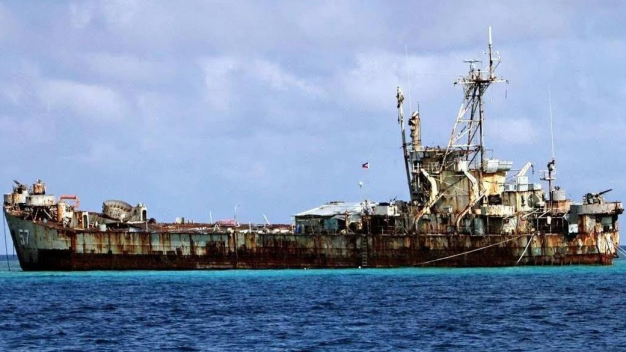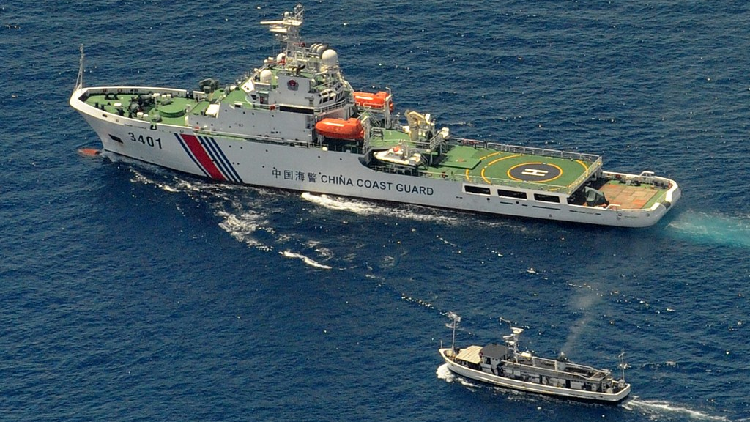
A rusted-out World War II Philippine warship "grounded" on Ren'ai Jiao for over 20 years. /Xinhua
A rusted-out World War II Philippine warship "grounded" on Ren'ai Jiao for over 20 years. /Xinhua
Editor's note: Xin Ping is a commentator on internationals affairs, writing regularly for Xinhua News, Global Times, China Daily, CGTN, etc. The article reflects the author's opinions and not necessarily the views of CGTN.
The South China Sea, stretching from the Strait of Malacca to the Taiwan Straits, is home to one of the busiest shipping lanes in the world. Each year, over half of the world's liquefied natural gas and a third of crude oil flow through the South China Sea. However, the waters have been beset by destabilizing undercurrents for decades due to geopolitical wrangling and external interference.
Tensions soared again when the Philippines accused the China Coast Guard of firing water canon against Filipino boats that were trying to send construction materials to a grounded vessel at Ren'ai Jiao. One of China's Nansha Islands, Ren'ai Jiao has long been part of Chinese territory. Its strategic location has put it in the eye of the storm as the maritime disputes heat up between China and the Philippines.
Historical narrative
The close call on August 5 was the most recent escalation of the 24-year-long dispute between China and the Philippines in the resource-rich waters. In 1999, under the excuse of "technical failures," the Philippines purposefully and illegally ran aground the BRP Sierra Madre, a crumbling World War II-era navy hulk acquired from the U.S., on China's Ren'ai Jiao.
Despite China's repeated demands for its rapid removal, the Philippines insisted that the ship could not be pulled away because of a "lack of parts." Since then, a group of more than a dozen Filipino marines and sailors have been deployed on the dilapidated battleship.
Out of humanitarian considerations, China established a temporary special arrangement with the Philippines which allows it to send food and other essential supplies to its marines on the BRP Sierra Madre. However, the Philippines decided to disregard China's goodwill and went ahead with shipping construction materials for large-scale refurbishment to the "stranded" vessel, viewing it as a "permanent military station," an act that inevitably encroaches on China's territorial sovereignty.
Stretched patience
China has shown maximum restraint to prevent potential escalation over Ren'ai Jiao. The fact that the "stranded" warship has remained in place for 24 years speaks volumes about China's patience. Unfortunately, moves by the Philippines in the past two decades clearly indicate that it has no plan to meet China halfway.

A Chinese coast guard ship and a Philippine navy vessel near the South China Sea, August 5, 2023. /CFP
A Chinese coast guard ship and a Philippine navy vessel near the South China Sea, August 5, 2023. /CFP
While pledging to tow away the illegally grounded vessel, the Philippines kept fortifying the warship on the shoal, in blatant violation of the Declaration on the Conduct of Parties in the South China Sea, which demands all parties exercise self-restraint in the conduct of activities that would complicate or escalate disputes.
Over the decades, China has repeatedly proposed to the Philippine side to sit down at the negotiating table and work out possible solutions but received little sincere response. And the changes of Philippine government with different positions on this issue also hindered progress in the few talks.
At the beginning of this year, on a visit in Beijing, Philippine President Ferdinand Romualdez Marcos Jr. reaffirmed the proper handling of maritime issues through friendly consultations. Yet growing provocations instead of positive interactions followed the visit, straining the foundation of mutual trust and leading to entrenched differences.
As a wild guess, the empty promises of towing away the vessel and having effective consultations with China might be nothing but the Philippines pulled off the trick of winning time for its illegal refurbishment project, thus seeking de facto control of the reef.
What's worse, by hyping up China's legitimate and lawful response as "dangerous and aggressive maneuvers," some with ill intent are trying to frame the innocent and throw mud at China. This kind of unfounded counter charges might sound bizarre, but it is in line with some Western countries' intention and practice.
Complaints abound among Chinese netizens about how one could tolerate others building illegal facilities and renovating them in one's own house for more than 20 years. Some even predicted that it would be the last time China is this lenient. "Just let it sink into the ocean," said one social media post.
Inviting wolves into the house
As always, whenever there is a friction in the South China Sea, one country from outside of this region will spare no effort to fan the flame while pretending to be the arbitrator. You guessed it right: It's the United States. No exception this time. From wrongfully accusing China as the one that is threatening peace and stability in this region to posing as the "authority" to judge the legitimacy of a country's rightful maritime claims, the U.S. acts as if it has the final say in the South China Sea. It has even brought out the 1951 U.S.-Philippines Mutual Defense Treaty as a paper tiger.
Needless to say, the increasing interference of the U.S. and some of its allies in the South China Sea is the major reason for growing geopolitical tensions in the region. The Philippines and the U.S. staged the largest ever "shoulder-to-shoulder" joint military exercise in April, flexing their muscles on China's doorstep.
As President Marcos Jr. leans towards the U.S. for closer security ties and shows a tougher posture towards China, it is advisable that the Filipinos think it through whether playing the U.S. card is worth the risk, and whether the Philippines can really benefit from the U.S.-orchestrated political drama.
Situated in the middle of the "first island chain" facing the Chinese mainland, the Philippines is an ideal staging post for U.S.'s "Indo-Pacific strategy." The U.S. is seeking to exploit Philippines' geopolitically important location and use it as a pawn to confront China.
Allowing external interference to stir up the South China Sea is like letting wolves into one's own house. If the Philippines continues to go awry over the South China Sea and further strain bilateral relations with China to serve America's political agenda, it could bring further uncertainties, if not turbulence.
The Philippines must stop going down the wrong path of trading its national interests and peace of the South China Sea for elusive U.S. support. Opening the door to thieves will not only hurt Philippines' own interests but also plunge the whole region into confrontation and turbulence.
(If you want to contribute and have specific expertise, please contact us at opinions@cgtn.com. Follow @thouse_opinions on Twitter to discover the latest commentaries in the CGTN Opinion Section.)